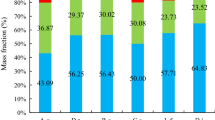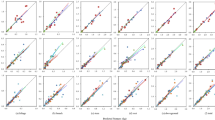Abstract
Allometric models are necessary for estimating biomass in terrestrial ecosystems. Generalized allometric relationship exists for many tropical trees, but species- and region-specific models are often lacking. We developed species-specific allometric models to predict aboveground biomass for 11 native tree species of the Sudanian savanna-woodlands. Diameters at the base and at breast height, with species means ranging respectively from 11 to 28 cm and 9 to 19 cm, and the height of the trees were used as predictor variables. Sampled trees spanned a wide range of sizes including the largest sizes these species can reach. As a response variable, the biomass of the trees was obtained through destructive sampling of 4 754 trees during wood harvesting. We used a stepwise multiple regression analysis with backward elimination procedure to develop models separately predicting, total biomass of the trees, stem biomass, and biomass of branches and twigs. All species-specific regression models relating biomass with measured tree dimensions were highly significant (p < 0.001). The biomass of branches and twigs was less predictable compared to stem biomass and total biomass, although their models required fewer predictors and predictor interactions. The best-fit equations for total above-ground biomass and stem biomass had R 2 > 0.70, except for the Acacia species; for branches including twig biomass, R2-values varied from 0.749 for Anogeissus leiocarpa to 0.183 for Acacia macrostachya. The use of these equations in estimating available biomass will avoid destructive sampling, and aid in planning for sustainable use of these species.
Similar content being viewed by others
References
Aboal JR, Arevalo JR, Fernandez A. 2005. Allometric relationships of different tree species and stand above ground biomass in the Gomera laurel forest (Canary Islands). Flora, 200: 264–274.
Arbonnier M. 2004. Trees, shrubs and lianas of West African dry zones. CIRAD Margraf, GMBH, MNHN, Paris, France.
Baskerville GL. 1965. Estimation of dry weight of tree components and total standing crop in conifer stands. Ecology, 46: 867–869.
Bellefontaine R, Gaston A, Petrucci Y. 2000. Management of natural forests of dry tropical zones. Food and Agriculture Organization of the United Nations, Rome.
Brocard D, Lacaux JP, Eva H. 1998. Domestic biomass combustion and associated atmospheric emissions in West Africa. Global Biogeochemical Cycles, 12: 127–139.
Brown S, Gillespie AJ, Lugo AE. 1989. Biomass estimation methods for tropical forests with applications to forest inventory data. Forest Science, 35: 881–902.
Chave J, Andalo C, Brown S, Cairns MA, Chambers JQ, Eamus D, Fölster H, Fromard F, Higuchi N, Kira T, Lescure JP, Nelson BW, Ogawa H, Puig H, Riera B, Yamakura T. 2005. Tree allometry and improved estimation of carbon stocks and balance in tropical forests. Oecologia, 145: 87–99.
Chidumayo EN. 1990. Aboveground woody biomass structure and productivity in a Zambezian woodland. Forest Ecology and Management, 36: 33–46.
Cole TG, Ewel JJ. 2006. Allometric equations for four valuable tropical tree species. Forest Ecology and Management, 229: 351–360.
Crawley MJ. 2005. Statistics: An introduction using R. Chister, England: John Wiley & Sons,.
Faraway JJ. 2005. Extending Linear Model With R: Generalized Linear, Mixed Effects and Nonparametric Regression Models. Taylor & Francis Ltd, Boca Raton, Fla USA.
Fearnside PM. 1997. Wood density for estimating forest biomass in Brazilian Amazonia. Forest Ecology and Management, 90: 59–87.
Grundy IM. 1995. Wood biomass estimation in dry miombo woodland in Zimbabwe. Forest Ecology and Management, 72: 109–117.
Ketterings QM, Coe R, van Noordwijk M, Ambagau Y, Palm CA. 2001. Reducing uncertainty in the use of allometric biomass equations for predicting above-ground tree biomass in mixed secondary forests. Forest Ecology and Management, 146: 199–209.
Komiyama A, Jintana V, Sangtiean T, Kato S. 2002. A common allometric equation for predicting stem weight of mangroves growing in secondary forests. Ecological Research, 17: 415–418.
Litton CM, Kauffman JB. 2008. Allometric models for predicting aboveground biomass in two widespread woody plants in Hawaii. Biotropica, 40: 313–320.
Navar J. 2002. Biomass estimation equations in the Tamaulipan thornscrub of north-eastern Mexico. Journal of Arid Environments, 52: 167–179.
Navar J. 2009a. Allometric equations for tree species and carbon stocks for forests of northwestern Mexico. Forest Ecology and Management, 257: 427–434.
Navar J. 2009b. Biomass component equations for Latin American species and groups of species. Annals of Forest Sciences, 66: 208–216.
Nouvellet Y. 1993. Evolution d’un taillis de formation naturelle en zone soudano-sahélienne au Burkina Faso. Bois et Forêts des Tropiques, 237: 45–60.
Nygard R, Elfving B. 2000. Stem basic density and bark proportion of 45 woody species in young savanna coppice forests in Burkina Faso. Annals of Forest Science, 57: 143–153.
Overman JPM, Witte HJL, Saldarriaga JG. 1994. Evaluation of regression models for above-ground biomass determination in Amazon rainforest. Journal of Tropical Ecology, 10: 207–218.
R Development Core Team. 2009. R: A language and environment for statistical computing. R Foundation for Statistical Computing, Vienna, Austria. ISBN 3-900051-07-0, URL http://www.R-project.org.
Savadogo P, Tiveau D, Sawadogo L, Tigabu M. 2008. Herbaceous species responses to long-term effects of prescribed fire, grazing and selective tree cutting in the savanna-woodlands of West Africa. Perspectives in Plant Ecology Evolution and Systematics, 10: 179–195.
Smektala G, Hautdidier B, Gautier D, Peltier R, Njiemoun A. 2002. Construction de tarifs de biomasse pour l’évaluation de la disponibilité ligneuse en zone de savanes au Nord-Cameroun. Actes du colloque, 27–31
Mai 2002, Garoua, Cameroun. Stromgaard P. 1985. Biomass estimation equations for miombo woodland, Zambia. Agroforestry Systems, 3: 3–13.
Tabachnick BG, Fidell LS. 1996. Using multivariate statistics. New York: Harper Collins College Publishers.
Ter-Mikaelian MT, Korzukhin MD. 1997. Biomass equations for 65 North American tree species. Forest Ecology and Management, 97: 1–24.
Whittaker RH. 1968. Dimension and production relations of trees and shrubs in the Brookhaven forest, New York. Journal of Ecology, 56: 1–25.
Wiemann MC, Williamson GB. 1989. Wood specific-gravity gradients in tropical dry and montane rain-forest trees. American Journal of Botany, 76: 924–928.
Willebrand E, Ledin S, Verwijst T. 1993. Willow coppice systems in short rotation forestry: effects of plant spacing, rotation length and clonal composition on biomass production. Biomass and Energy, 4: 323–331.
Zianis D, Mencuccini M. 2004. On simplifying allometric analyses of forest biomass. Forest Ecology and Management, 187: 311–332.
Zuur AF, Leno EN, Walker NJ, Saveliev AA, Smith GM. 2009. Mixed effects models and extensions in ecology with R. New York: Springer-Verlag,.
Author information
Authors and Affiliations
Corresponding author
Additional information
Foundation project: This work was provided by Swedish International Development Cooperation Agency (Sida).
Rights and permissions
About this article
Cite this article
Sawadogo, L., Savadogo, P., Tiveau, D. et al. Allometric prediction of above-ground biomass of eleven woody tree species in the Sudanian savanna-woodland of West Africa. Journal of Forestry Research 21, 475–481 (2010). https://doi.org/10.1007/s11676-010-0101-4
Received:
Accepted:
Published:
Issue Date:
DOI: https://doi.org/10.1007/s11676-010-0101-4




